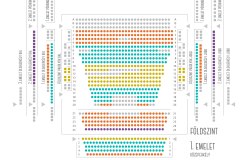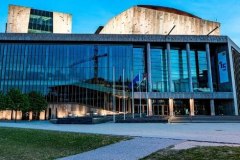Frenák Company, Birdie
Mo | Tu | We | Th | Fr | Sa | Su |
Confinement and isolation, freedom and endlessness. FrenÁk’s emotionally charged choreographic structures use dynamic forms of movement to gain visibility and captivate the audience. The performance moves on the borderline between harsh reality and imaginary visions, where listening to our inner voices demands an unconscious balancing act on the edge of madness. The Birdie of the title, which also drew inspiration from William Wharton, seeks a way out of the revolving metal structure of a labyrinth. The dancers forge a path through an invisible maze that is in constant motion at once in the vertical and horizontal plane, while the spinning element opens up new spatial forms and enables a whole new world of movement. The concept and soul of the piece convey the idea that if we deny the world transparency and the ability to sense perspective, as well as the freedom of movement, it will rebound on us as psychological and physical trauma. Accorging to FrenÁk: “Our whole lives are a madhouse. To what extent this is a symptom of our age is difficult to determine. I was interested in how we handle our personal circumstances within this realm, in whether we are able to rise up from our own confinement.”
The premiere was an event of the Budapest Spring Festival, presented by Müpa Budapest and National Dance Theatre.
Program and cast
dance: Péter Holoda
Dominik Gyugos
Gergő Cserháti
Emma Lőrincz
Zsolt Szlavoszky
Eoin Mac Donncha
Latasha Pugh
cello: Endre Kertész
Creators:
music: Norman Levy
lighting: Máté Vajda
set design: Dániel Lakos, Tervhivatal/Planbureau
choreography and concept: FrenÁk
costume designer: Victoria Frenak
alpine technology: György Zoltai
Palace of Arts Müpa Budapest
When Müpa Budapest, Hungary and its capital's new cultural hub, opened in 2005, it was built to represent more than 100 years of Hungarian cultural history. As a conglomeration of cultural venues, the building has no precedent in 20th century Hungarian architecture and has no peers in the whole of Central Europe.
The creators of this ambitious project, the Trigránit Development Corporation, prime contractor Arcadom Construction and the Zoboki, Demeter and Partners Architectural Office, were driven by the desire to create a new European cultural citadel as part of the new Millennium City Centre complex along the UNESCO World Heritage-listed Danube waterfront. The result is a facility whose construction quality, appearance, functionality and 21st century technological infrastructure makes it ideally suited to productions of the highest standard. The building is also highly versatile and equipped to host performances of any genre and almost any scale.

 EN
EN DE
DE IT
IT FR
FR ES
ES RU
RU JP
JP RO
RO
 Seating plan
Seating plan 